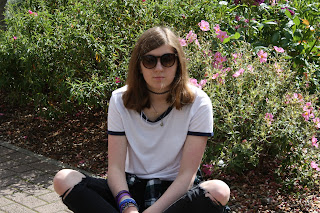Equipment Used:
Canon EOS 450D, standard lens, tripod.
Settings:
1/100, F/6.3, ISO 100
Lighting:
Natural outdoor lighting.
Theory:
Ann Gould: Youth subculture; rebellious, artificial tribe.
Albert Cohen: Youth subculture; moral panic, fold devils: subverting conventions.
Favourite:
This gif is my favourite of the series for a few reasons. Firstly, the object is designed to show movement and thus the gif captures it well. Also, the images overlapped well as I used the continuous shooting mode which means the movement is more flowing that if I took a few more sporadic photographs. Furthermore, the flowing of the fabric and hair also adds another dimension of movement for the gif to display. Additionally, the clean backdrop landscape of the photo ensures that the viewer's attention is solely on the subject. Moreover, the lighting for this particular photograph is good in that the image does not appear too bright due to the limited section of sky within the photograph compared to the image featured below as least favourite. Also, the timing that I chose in Photoshop to create this gif works in cohesion with the movement in that it does not appear too fast or too slow; this could link to the concept of children growing up too fast and adults taking life too slow and responsible whereas teenagers are victims of both. Therefore, the concept of the series is also another thing that I think this image depicts nicely; the difficulty faced by teenagers to find a place where they belong for they are busy negotiating similar choices as adults but still needing certain reassurances and senses of belonging like a child.
Least Favourite:
This image is my least favourite of the series. To begin with, the climbing frame used to capture the gif was a bad composition choice on my part in that it fails to show movement as well as the other elements did; in addition to this, the limited space meant that fewer frames could be used to make the gif. Consequently, the fewer frames but same Photoshop time frame as used in the photograph above created a jumpy and sporadic movement, which is a technique some photographers like from gifs but was not what I was aiming for, is another reason this image is my least favourite. Additionally, the lighting in this image is marginally too bright and could have benefitted from me changing the F/stop value or the shutter speed as the ISO is already very low; for example, I could have increased the shutter speed to around 1/125 or possibly even up to 1/160. Also, the background is not as clean as in the previous gif as there is movement from a person in the background in the bottom right segment of the grid which distracts from the main subject of the photograph. Despite this, the concept for this photograph is still a redeeming feature. The image metaphorically depicts the climb down, as a teenager, from an elevated time of imagination in childhood to a more realistic grounded view from the bottom which symbolises adulthood.
Evaluation and Development -
This particular experimentation of possible techniques that could be implemented in future shoots has been enjoyable and as a result has created dynamic final photographic outcomes that has lead to engaging and entertaining moving images. The success lies in the landscape and props used which resulted in a more interesting final gif than a series of photographs that were in themselves mostly static.
I would like to use this technique again in the future to incorporate surrealist ideologies; for instance, the idea of a static photograph showing movement inside its framing is in itself surreal. It would also be interesting to explore fashion surrealism in movement; a photograph shown to the masses displaying fashion in movement like on the catwalk but in reality.
I would like to use this technique again in the future to incorporate surrealist ideologies; for instance, the idea of a static photograph showing movement inside its framing is in itself surreal. It would also be interesting to explore fashion surrealism in movement; a photograph shown to the masses displaying fashion in movement like on the catwalk but in reality.




















































